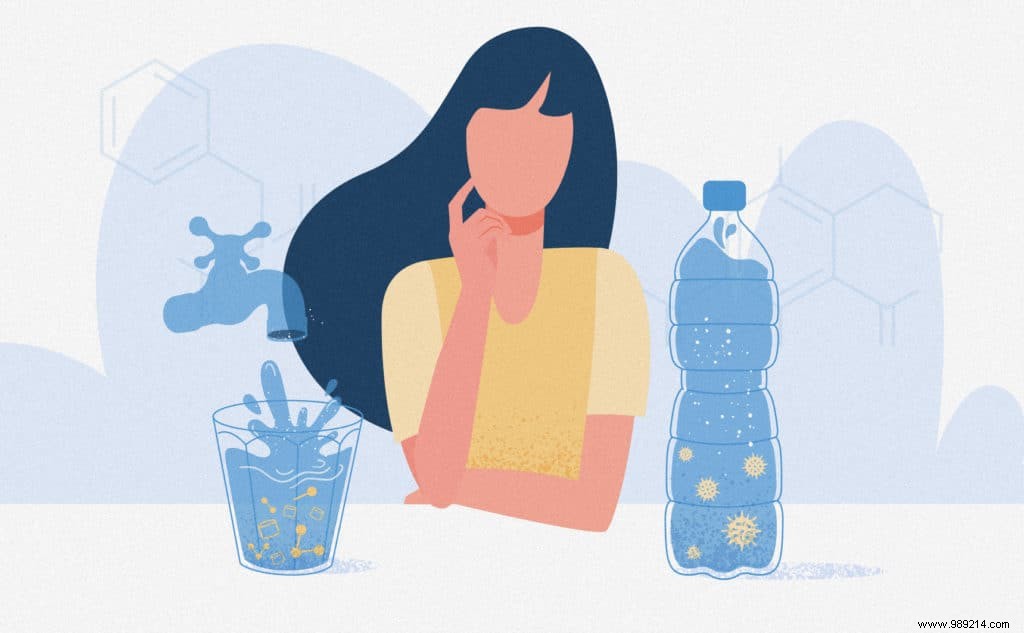
When it comes to drinking water, two clans clash:tap water proponents on one side and bottled water proponents on the other. Price, environmental impact, health aspect, we take stock of their advantages and disadvantages.
At the tap or in the bottle, all this water is drinkable and intended for human consumption. And yet, certain specificities distinguish them. Tap water comes from underground and surface catchments (rivers, lakes, etc.). It is “the most controlled food product”, indicates the National Agency for Food, Environmental and Occupational Health Safety (Anses). It undergoes treatment in order to respect the microbiological, physico-chemical, radiological and organoleptic parameters set by the Public Health Code and is monitored by the regional health agencies (ARS). It is also chlorinated to disinfect it and kill bacteria present in the pipes.
Bottled water, mineral or spring, are exclusively of underground origin. Their composition is also strictly verified, but they cannot be subject to disinfection treatments. Natural mineral waters, which as their name suggests contain minerals, may have different fluoride concentrations than tap water. Not all of them can therefore be suitable for daily use and it is better to seek advice from your doctor.
In terms of composition, according to the UFC-Que Choisir association, “pollution tap water by nitrates is becoming rare, and exceedances of pesticide standards infrequent" . However, Future Generations has studied the results of the health checks carried out by the ARS in 2019 and it appears that the majority of pesticide residues are suspected endocrine disruptors whose long-term action potential, even at low doses, worries long. This calls for a sharp reduction in the use of phytosanitary products. Regarding the presence of lead, regulations have tightened in recent years and public connections have been replaced. However, the problem may persist in older homes, where it is recommended to avoid consuming the first spray in the morning.
As for bottled water, a study published in 2018 on the Orb Media platform of eleven major global brands showed that 93% of them contained microplastics. These were present in varying amounts, but were on average twice as numerous as in tap water. However, we do not yet know their impact on health.
Financially, tap water wins the game. According to the calculations of UFC-Que Choisir, it is worth an average of 0.003 euros per liter, with nevertheless disparities according to the territories. The price of spring water is on average 0.20 euro per liter and that of mineral water 0.40 euro. These last two also show a significant environmental cost because of their transport by truck which emits greenhouse gases and their plastic packaging which produces waste - on average 10 kg per year and per person - which must be retreat.
Another criterion of choice:the taste aspect. The chlorine taste is the main criticism of tap water. To eliminate it, ANSES recommends letting the water stand "30 minutes in a carafe before consuming it" . Bottled waters, for their part, each have a different flavor, linked in particular to their mineral content, the catchment area or their composition, which can vary over time for spring waters. Finally, to better preserve them, ANSES recommends storing the bottles “sheltered from the sun and the temperature, in a cool place” .
Update on water filter jugs
Filter jugs, equipped with an activated carbon filter, promise to improve the quality of tap water. But the National Agency for Food, Environmental and Occupational Health and Safety (Anses) believes that their use "can lead to the release of various contaminants (silver, sodium, potassium, ammonium ions) into the drinking water. drink, to a lowering of the pH, or even to an alteration of the microbiological quality of the water", in an opinion published in March 2017. It specifies however that "the available data do not make it possible to highlight a risk for health of the consumer". To limit the potential deleterious effects, ANSES recommends:following the instructions for use and precautions for use, cleaning the carafe frequently, replacing the cartridge regularly, storing the water in the refrigerator and consuming it within 24 hours.
What about carbonating machines?
Machines that transform tap water into sparkling water are a real success. Their manufacturers put forward the ecological argument – the same plastic or glass bottle is reused – to encourage consumers to equip themselves. The magazine 60 Millions de consommateurs estimates, in its April 2018 special issue, that "thanks to the machines, 1,000 bottles are saved over three years, or about 30 kg of plastic (PET) [for a family] which will not need to be recycled". However, these figures are to be put into perspective if we use concentrate refills to add to tap water and which make it possible to make sodas. These bottles are not all recyclable. The CO2 cylinder is reusable. You have to bring it back to the store to exchange it. The use of these machines does not a priori pose any health problem provided you do not abuse homemade sodas, even if, according to their labels, the concentrates contain less sugar than classic sodas.